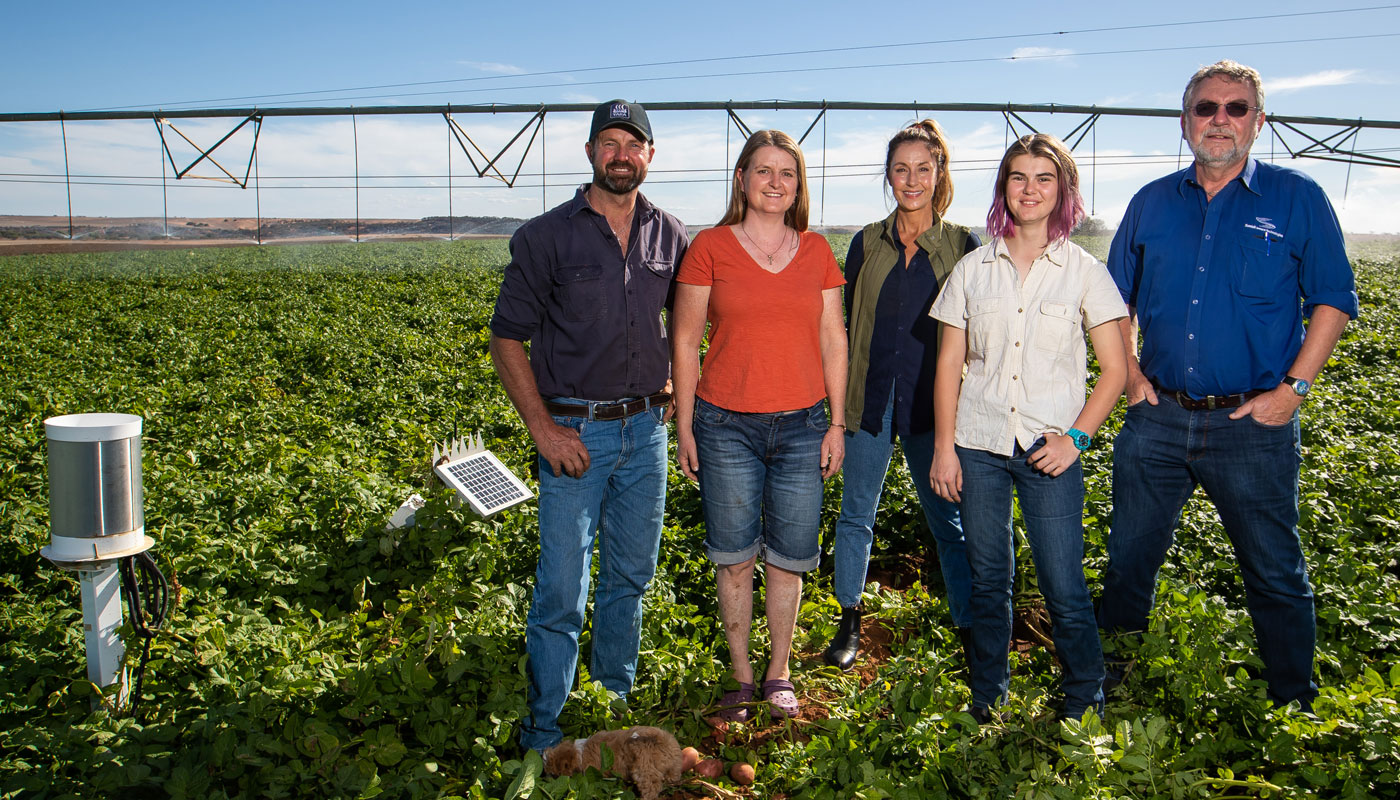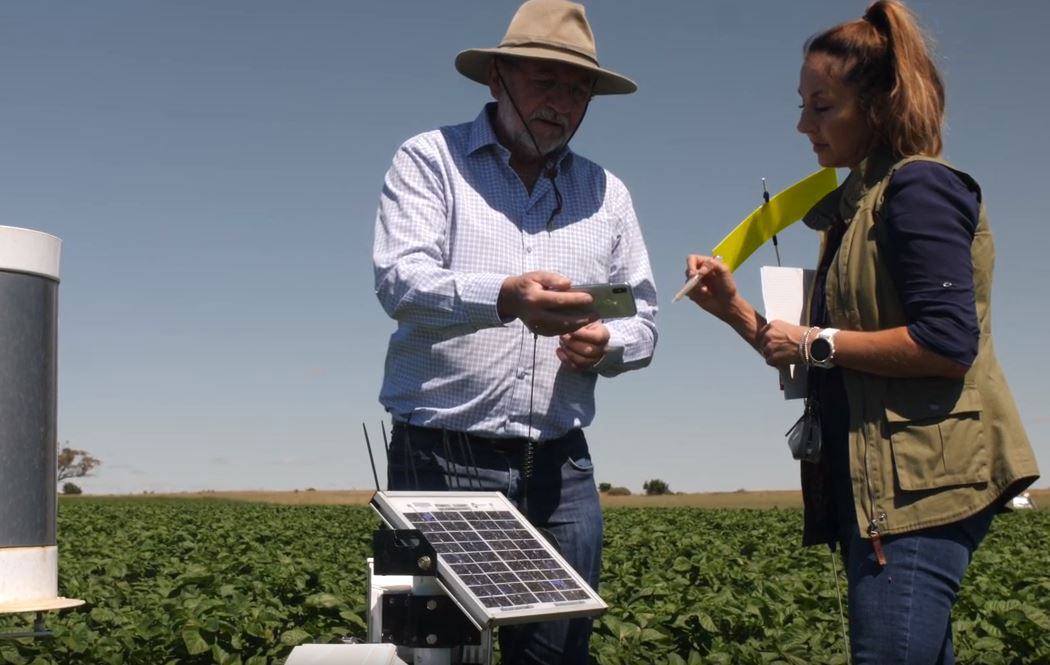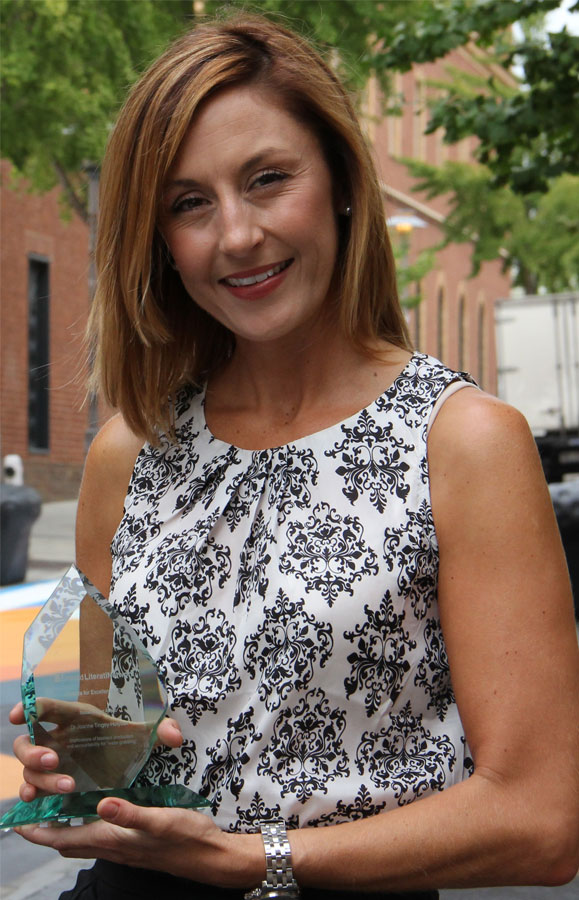News Accounting for water: new interdisciplinary approaches help increase water productivity on farms
J-WAFS’ new visiting scholar combines strategies from accounting and agronomy to sensing technology to help farmers save water
Andi Sutton, Abdul Latif Jameel Water and Food Systems Lab February 6, 2020

A subset of the WaterLink Potatoes Project Team on a potato field standing under a centre pivot irrigation system. WaterLink is a new decision-support tool that incorporates farmers' financial data with information from field sensors to inform better water management practices. From Left to Right: Aaron and Liz Haby (owners, Forster Hill Potatoes), Joanne Tingey-Holyoak (Lead Researcher, UniSA), Chelsea Haby, and Peter Buss (Sentek Pty Ltd). Credit: James Elsby, Clique Media
Starting mid-February, J-WAFS will be welcoming a new visiting scholar from Adelaide, Australia, Joanne Tingey-Holyoak. Dr. Tingey-Holyoak is a senior lecturer and researcher in sustainable engineering in the Accounting and Law Group at the Centre of Sustainability Governance at the University of Southern Australia (UniSA) Business School. She is a certified practicing accountant as well as a certified professional agronomist, and she brings these two professional and disciplinary approaches together with her passion for water in order to develop tools to improve water management practices at the farm scale as well as the international level. Her goal is to improve decision support resources farmers and policy makers have by developing tools and metrics that result in more effective national and international water conservation practices and policies.
J-WAFS communications and program manager Andi Sutton talked to Dr. Tingey-Holyoak about her research and what she is hoping for during her time at MIT. Readers interested in finding out more about her work can also attend her upcoming seminar series on water accounting and decision support tools.
What was your original inspiration to work on water and food systems?
While working on my PhD in sustainable agricultural water management at UniSA, my research was focused on water storage practices in Australia and around the world. This work supported a larger discovery project by the Australian Research Council led by Associate Professor John Pisaniello, which aimed to discover a model for ecologically sustainable and safe surface water storage in dams. . My particular focus was on farmer water storage behaviors and how we can better inform what farmers are doing on-field by specifically applying accounting concepts and models to water. I was excited by how the unique perspective I brought from my background in accounting could make a real difference in water.

Joanne Tingey-Holyoak undertaking on-site measurements with Sentek R&D manager Peter Buss for her WaterLink project which seeks to integrate soil moisture and climate data with accounting and farm business data to improve water productivity. Credit: University of South Australia, Central Marketing
For this study we spoke to over 400 farmers in four states of Australia representing the extremes of water storage management policy–South Australia, New South Wales, Victoria and Tasmania. Through these conversations, I began to understand that farmers were already introduced to a lot of information—new data streams, direct monitoring, climate models, etc.—but this information wasn’t actually very useful to them. They were either not able to integrate the information into their complex lives and work practices, or they were quickly internalizing it and moving on. I wanted to develop something that was better linked to their individual business practices—something that could make this barrage of information useful.
What were these farmers’ perspectives on water conservation for the environment versus their needs?
It is interesting…a lot of farmers believe that there needs to be more water allocated to the environment to support surrounding ecosystems. Most are really very environmentally aware and concerned about future water availability around the world. But they are also concerned about issues of productivity and profitability at the same time. In Australia, we are seeing a moment where the policy-driven water initiatives such as the water markets being built and efficiency funding that is being made available are causing some smaller producers to disappear. But we are also seeing that the ones that are surviving are extremely tough, and want to work with the available water to be more sustainable in their own operations while also responding to the broader issues that affect the environment around them.
What drew you to J-WAFS and to MIT?
I follow J-WAFS on Twitter and have been interested in your work for a while. Looking at all the research and innovation coming out of your center, what excites me in particular is the cross-disciplinary reach. Working across five schools at MIT—that’s a lot of disciplines that you cover. It clearly gives J-WAFS a helicopter view of what’s going on to solve water and food problems and allows you to connect people to each other, even when they’re working in different areas. Since my work is also interdisciplinary, this approach was a great fit.
Particularly what excites me about coming to MIT was the opportunity to connect with others who are working on sensors and other new tools that integrate information from different places to support farmers. At MIT you have researchers who are supported by J-WAFS who are developing soil sensors—like Dr. Chintan Vaishnav at Sloan and Professor John Hart in Mechanical Engineering—as well as researchers applying remote sensing to sustainable agriculture—such as Professor Dara Entekhabi and Dr. Sarah Fletcher in Civil and Environmental Engineering. What I’m interested in is linking this work to social science and the economic science of accounting to create tools that link things like soil, weather, and climate forecasting to farmers’ financial information in order to inform their decision making. I strongly believe that we can’t solve big food and water systems problems without interdisciplinary solutions, and I look forward to learning from research happening at MIT to help further my own projects.
In my own work, I’ve developed a tool with my industry partner, Sentek, called WaterLink, which links together information pulled from in-field sensors such as soil moisture, salinity, temperature, and rainfall, weather and climate information, and data on irrigation flow and water use and combines it with farm accounts. In developing this tool, I saw that I am reaching a limit to what I and my collaborators can achieve in Australia. We would like to expand the scope of the tool so that it could be used in the developed or developing world, especially where farmer accounting systems may not be automated.
My specific challenge is to develop a technology that is not just contextualized, but also incentivized. It has to do with marrying up the goals and priorities at the farmer level to those at the policy level. And, this is something we haven’t nailed yet in many places. For example, the sensors that currently exist on the market that measure soil moisture or nutrient content provide accurate information, but if they’re not embedded into farmer decision making then they’re not as useful, and this makes these sensors another unnecessary application. They can sometimes even be detrimental if their aim is to increase water use efficiency, which can result in increased local water consumption, which reduces return flows to aquifers and drains. If we can’t contextualize the data in lived experience, we can’t improve farmer productivity or improve outflows to downstream users and the environment.
Tell me more about WaterLink.
WaterLink is an industry-based research project, and currently exists as a developing software tool. My industry partner developed the on-field sensors and agronomic inputs that the tool uses, and I and my research team linked their data to accounting and budgeting through a series of algorithms. To develop it, we are currently in our fourth season of data—from potato farming—and coming into our third season in viticulture. The result is a personalized system that builds basic cost tracking in so that a cost analysis is included with the other information farmers receive.
The system will also be able to provide cost-informed alerts about things like plant stress, disease, and how much it might cost to get out of a particular situation. For example: if a drought is projected, what would the detriment to yield value be to harvest early vs. the potential cost of round-the-clock irrigation to keep the plants' rootzone moist? We also hope to support forecasting, which could help farmers use water more efficiently. A farmer could, for example, look to see what the yield impact could be if she chose not to irrigate at a point when water use would be particularly expensive. She could look at different possible outcomes based on whether she did or did not irrigate in order to make a cost-informed decision. While we have scoped the project to be big, it is currently in a prototype stage.
What new direction in your research are you really excited about right now?
The way that technology is developing to support decision making is so central to the future of food and water systems. We can’t ignore the challenges, and more data is needed to find solutions. I find that there is a rush to develop tools, but I don’t see that they’re always as useful as they could be. And then, in my encounters with farmers, I have found that there is some fatigue out there when it comes to new tools. Growers may have had a bad experience with one tool, which makes them disinclined to try something else. If we can ensure that technology is rooted in better informed scenario models and decision-making strategies—not just pure numbers, but how these numbers link to what growers want and need that is specific to their regions and countries—we could really improve upon past practices and grow into a more sustainable future. Tools like these could also really help people understand their impact on the water system more broadly.
I also am excited about the potential of largescale take-up of small-scale technology. It can really have a big impact! If you can encourage all growers to use a particular water information system, you can capture valuable information about water use as a whole. I’m not there yet with my research, but this is a passion of mine for the future: how can we use this micro-technology to inform macro-policy making? Even in Australia we don’t know precisely the amount of water we have and what we are doing with it. We don’t measure it well, and accounting is the missing piece.
Dr. Joanne Tingey-Holyoak will be a visiting scholar at J-WAFS for three weeks during the spring semester. Find out more about her here.

Joanne Tingey-Holyoak holding a Social Impact Award from Emerald Publishing House in 2013. Credit: University of South Australia Central Marketing